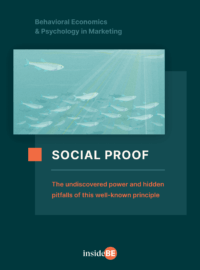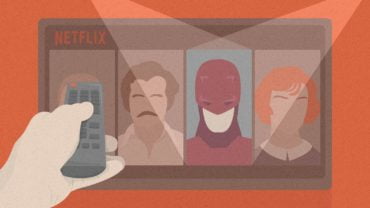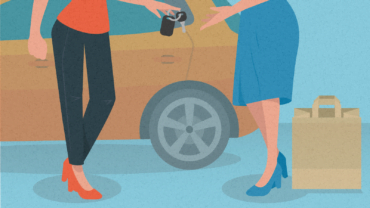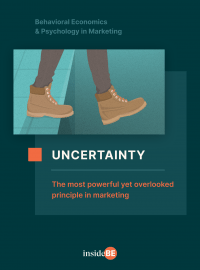Social Proof – Everything You Need To Know

When we’re not sure how we should behave, a critical source of information we draw from is other people’s behavior. Learn how you can use this bias to steer customers’ decisions and how to avoid it when you’re the customer.
Article content:
Defining Social Proof
Social proof is the tendency to be swayed by other people’s choices, especially in ambiguous circumstances. That’s when we tend to look to those around us for clues about what the ‘right’ way to behave is.
Social Proof
Social proof is our tendency to be influenced by what others do, how they think and behave. Social proof works particularly well in situations of uncertainty.
It’s the reason you’ll remain seated even though you’re itching to stand up and walk around during the third hour of a brainstorming session. But as soon as someone more daring stands up, you follow suit.
Social proof is the reason it feels strange not to have your camera on during a Zoom call when everyone has theirs on; and the reason why we would put our masks on and then cast them aside at the drop of the hat (pun intended) during the COVID-19 pandemic.
How does it work?
Remember that famous diner scene from When Harry Met Sally and that classic one-liner “I’ll have what she’s having”? Social proof works just like that! When we’re acting based on social proof, we aren’t aware that the choices we make are arbitrary. When we rely on social proof, we aren’t acting rationally. We simply rely on a shortcut: if people like it, then it’s probably worth it.
Social proof works particularly well in situations of uncertainty. It's a huge help for undecided or indecisive customers as it signals the preferred option and helps build trust.
Social proof works particularly well in situations of uncertainty. It’s a huge help for undecided or indecisive customers as it signals the preferred option and helps build trust.
Why does it work?
The evolutionary explanation is that this “copycat strategy” is helpful in a world where humans are born prematurely (at least in comparison to other mammals) and asked early on in their lives to perform complex tasks.
Imitation is quicker. A “monkey see, monkey do” approach saves us time and energy because it provides ready-made solutions to various problems. So, as little children, we learn many things quickly, which we can modify later if need be – but sometimes we don’t. And that’s when social proof “shortcuts” take over.
Not to mention that any diversion from how the group behaves is threatening and potentially harmful. Usually looking at what the majority of people are doing is a right indicator of what the correct course of action is.
But it can also lead to diffusion of responsibility.
For example, we are less likely to help out a stranger if surrounded by a large group of people who also are doing nothing (the bystander effect). We won’t report smoke in a room if other people aren’t concerned about it either. And, fun fact, we are less likely to flag (report) a YouTube comment if many people have already done so.
However, even though social proof can sometimes make us passive, reading social information accurately is an essential skill to have (it can literally save your life, safeguard you from social embarrassment, and more). Imagine you’re in a burning movie theater and everyone’s rushing to the door whilst you remain seated – ignoring what others are doing in this scenario is definitely a fatal mistake for you.
Since it’s one of the most prevalent techniques, customers are used to seeing it to the point where they’ve become immune to social proof or – straight up – overlook it.
And it’s no wonder that social proof is used as a marketing technique to get people to buy certain products.
Since it’s one of the most prevalent techniques, customers are used to seeing it to the point where they’ve become immune to social proof or – straight up – overlook it. Think of it as antibiotic resistance – the more traditional ways of using social proof still work, but they might not work as well as they used to.
That’s why we’ll explore both classic and more innovative ways to use social proof. We’ll also point out when it can be used the wrong way and become harmful for your bottom line.

Discover ground-breaking ideas and fascinating solutions.
Social Proof Experiments
Don’t drop that towel
We can see how the actions of others influence us when we’re around them, but could the actions of strangers we’ve never even met inform us of what choices to make?
Dr. Robert Cialdini, a professor in Psychology, wanted to test out this idea. He wondered if by changing the text on the “eco cards” in hotels he could get more people to reuse hotel towels.
Remember the card in the bathroom prompting you to reuse your bathroom towels? It’s often a standard environmental appeal – the one we all mostly ignore – “Save water, care about the planet.” It’s not like you don’t care but you still drop the ball by dropping the towel anyway.
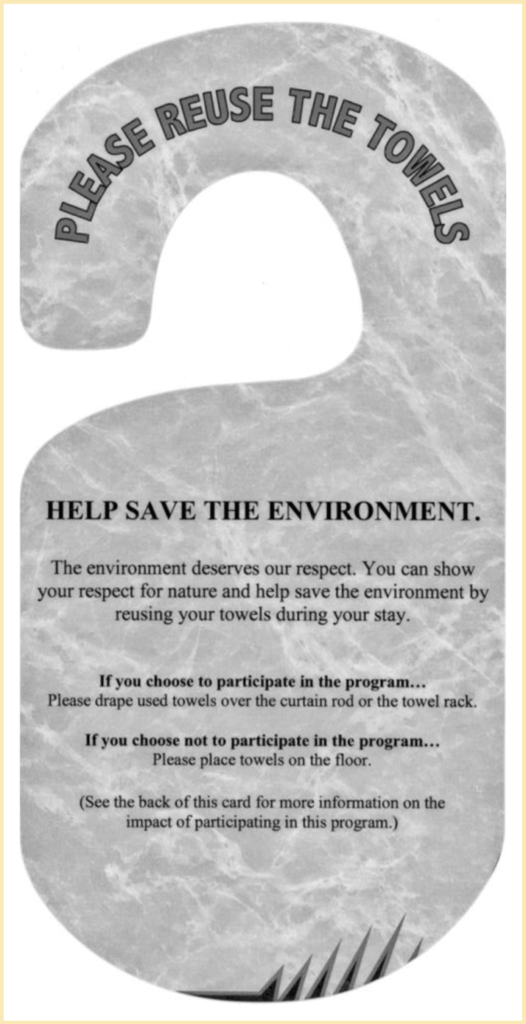
Source: A Room with a Viewpoint: Using Social
Norms to Motivate Environmental
Conservation in Hotels
Cialdini hypothesized that this could be fixed if we simply told people that others don’t drop their towels! He designed several cards using social proof.
The first card read: “The majority of our guests reuse their towel at least once.” Visitors who saw this became 26% more likely to reuse their towel than those who saw just a standard environmental appeal.
The second card read: “The majority of guests who stayed in this room reused their towel at least once.” 49.3% of those who read it reused the towel, leading to a 33% increase in towel-reuse participation compared to the standard environmental appeal.
According to Cialdini, the second group felt a closer connection to those who stayed in the same room as they did. Which brings us to a simple rule – social proof is most effective when the reference group is as similar to your customers as possible.
Ditch the AC, switch to a fan
Another study conducted by the Wall Street Journal and spotted by CXL focused on how to get more people to decrease their energy usage in the summer by switching from air conditioners to fans.
Here homeowners were informed that:
- they would save $54 a month (nice!);
- it would prevent the release of more than 262 pounds of greenhouse gases a month (not too shabby!); and
- that 77% of their neighbors had already started using fans! (cool!)
Though the first two reasons might feel like a stronger case of ditching that good old air conditioning, the majority of people who agreed to switch to fans said they were doing so because their neighbors already had.
This is a great example of how persuasive social proof can be, particularly when it is prominently placed on your landing page and other important sales pages.

Discover ground-breaking ideas and fascinating solutions.
A History
Though the term “social proof” was first coined in 1984 by Robert Cialdini (remember him from the towel study?) in his best-selling book, Influence: The Psychology of Persuasion, earlier work of Solomon Asch’s – a pioneer of social psychology – provides ample evidence of how big group influence can be.
In 1951, Asch told his 50 college-age participants that they were going to participate in an eye test. Unbeknownst to them, they entered a room with seven people who were also in on the experiment. The study had nothing to do with their eyesight, it was about whether in the presence of undisputed evidence people would buckle under the pressure of social influence.
Source: YouTube
Each person was shown a picture of a target line next to three other lines A, B, and C (including our unwitting participant) and asked which line was most similar in length to the target line. The answer was always fairly obvious, however, on some of the trials, the seven “confederates” intentionally gave the wrong answer.
The only person who wasn’t in on the experiment was the last person to answer, after they had heard all the other answers. And guess what! 75% of the time these people would give the incorrect answer despite their own eyes!
In 1962, Asch continued to explore social influence to see if people would still look for social proof to know how to behave outside of the laboratory. His “Face the Rear” examined people’s behavior getting into elevators. This is the case in which an image is worth a thousand words. And it’s actually quite funny to watch.
Source: YouTube
As seen in the video, Asch’s confederates were already in the elevator and faced towards the back when the unknowing victim entered the elevator. Even though facing the back of the elevator is highly unusual, people mimicked this behavior and stood in the same direction. They even turned around for no apparent reason other than that “the herd did it.”
You can see looks of confusion on their faces but they can’t help it – the response is almost involuntary. That’s what Asch initially called herd behavior.
How to avoid it
Can we resist the power of social proof mind games? Yes, certainly it’s easier when it’s right there “in your face.” That’s where psychological reactance is our ally. We have a need for freedom and autonomy and as a result, we hate to give up our agency.
Studies show that if we feel somebody is trying to persuade us, we react against the potential loss of control and their message becomes less effective.
Studies show that if we feel somebody is trying to persuade us, we react against the potential loss of control and their message becomes less effective. This is also true for pushy, overly-blunt messaging such as (e.g., “the best deal ever”, “buy this product”).
But it’s harder to do when what we need is reassurance and certainty. One way to fight back is to create our own certainty. A group of researchers in 1970 did an experiment which focused on a problem-solving task and demonstrated that if we have enough information to be certain of our own decision, we won’t budge or yield to the decisions of others.
So whenever you’re faced with making a choice that you don’t feel qualified to make, don’t know much about, or that makes you feel rushed – be sure to question the authority source. Is the “wisdom of the crown” really the best source of expertise on which new gadget or gear to buy? Perhaps they have different needs than you do.
You can reinforce your persuasion armor if you do our own research first and don’t rely on knee-jerk, gut feeling decisions of what the herd chose.
Examples and Case Studies
Let’s look at businesses that use social proof to make choosing easier.
Netflix recommendations
Choice Overload
Choice overload is a result of too many choices being available. It can result in decision fatigue, sticking to the default option, or even avoiding making a decision altogether.
Netflix is the famous bud of a joke for having too many things to choose from; it can be debilitating. Unsure what to watch, you find yourself endlessly scrolling through the Netflix library to the point of getting fed up and dissatisfied with what you’ve picked.
So how does the company tackle choice overload, the nemesis of sales and customer satisfaction?
Yes, one of the ways to make choosing easier is to show what others have been up to.
The titles Netflix would like you to watch most are its originals. But watching something new feels like buying a pig in a poke. Am I gonna like it? Will it be a waste of time?
So on Netflix’s home page, social proof does more than reassure people. It also induces risk of loss by creating FOMO. If everyone is watching something, we might not want to miss out on it or worse, be out of the loop.
Netflix has built not just one but two submenus to tackle this concern:
- Trending now: a slightly ambiguous title titillates our curiosity.
- Top 10 in your country: a more salient display signifies that this is something worth paying attention to.
Now compare it to other streaming platforms who don’t use it and you’ll see that committing to watching new titles from the inhouse production feels less easy.
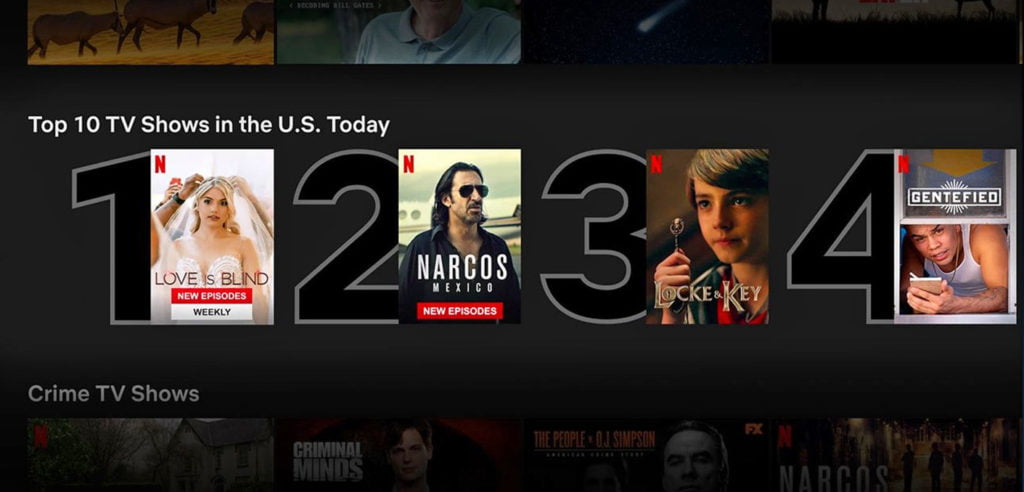
Source: Netflix
The Zara app checkout funnel
ZARA is a great example of using social proof in an innovative way. When purchasing an item of clothing online via their online app, it guides you through a series of questions regarding your measurements, specific body shape of certain bodily areas, and your age to find you the optimal fit.
At the end of the funnel, you’re given your ideal size. Pretty standard, right?
What ZARA does differently is that along with this information, it gives you the reassurance that the majority of people who have entered the same measurements, age, and fit preferences and have bought this item were satisfied with it. This is a textbook example of the right use of social proof at the right time. It shows that ZARA has understood that crucial moment of highest uncertainty when social proof helps to provide the right justification.

Source: Zara
Getting more women to use car-sharing
Curiously, women are more likely to engage in herd behavior; therefore social proof is even more effective for them. But if they don’t see other women engage in a certain kind of behavior, it discourages them even more.
But what to do when there’s no social proof and in fact, there’s negative social proof?
MOL Limo, the leading car sharing company in Hungary, faced this obstacle when trying to tackle the gender disparity of its users (approximately 65-75% of them were men) and attract more female drivers to give car sharing a try.
But the lack of visibility of female users have hindered other womens’ willingness to use the service.
One of the ideas that Hungary-based behavioral consultancy BeHive proposed was to give a reference group approval. Basically to show women (among which car sharing was still a minority) that car sharing would be a great option for them.
For this, the team relied on dynamic social norms, which shows that a product or service is growing in popularity (it doesn’t mean it is popular yet, but it’s on the right track).
An example of this could be: “The number of people who use online banking apps increased by 60% from 2018-2021.” A similar trend was also found among female car sharing users, as the number of customers who were using the service was increasing, but the company was not communicating it.
To read more about other biases women are more prone to as well as a plethora of solutions to fix it, click below to read the case study.
How one job portal increased its conversion rate
The goal of every job posting site is to ensure job seekers engage beyond just viewing the job ads and actually press “send CV.”
A job posting site JobAngels struggled to increase the number of applicants. To add insult to the injury, they couldn’t change what the posts looked like, they could only change the overall interface.
But is it possible to boost job ad conversions without changing a single word in the job ad? Yes, it can be a piece of cake with a proper understanding of social proof.
With the help of behavioral experts from Mindworx, they dove deeper into the mindset of the job seeker.
In the end, they tried something that defied logic at first glance, but proved to work. It was showing job-seekers how many people have already applied for the position they’re looking at! They ran the test for several weeks and were shocked by the results.
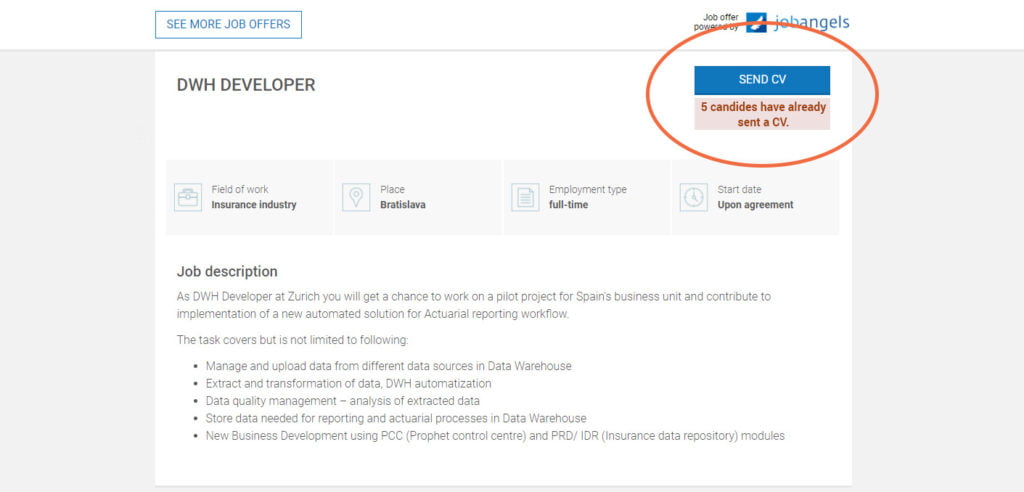
Source: JobAngels
The number of jobseekers sending in their CV when social proof was introduced went up by 138%!
It may seem counterintuitive – Why tell a job seeker that a whole crowd of people have already beaten them to the chase? But it turns out that in a situation of uncertainty, people look to others to see what the right course of action is. The more people that applied, the more attractive the posting was.
How to use social proof in business?
A powerful tool in situations of uncertainty
We’ve written a whole article on uncertainty and why we think it’s the number one sales and conversions killer.
When people are uncertain, they’re more likely look to others for behavioral guidance.
Basically, when people are uncertain, they’re more likely look to others for behavioral guidance. Thus, in order to harness the power of this phenomenon, first identify your customers’ uncertainties and then nip them in the bud with the appropriate dose of social proof (remember ZARA).
To paraphrase Growth Marketing Expert Angie Schottmuller, if there’s little uncertainty, social proof might not have a great impact. But if there’s notable uncertainty and weak or no social proof, the negative conversion impact might be remarkable.
Rely on the majority of peers
Don’t just say what many people do, say what the MAJORITY does. Social proof is the most effective when the reference group is as relatable to your customers as possible.
This means adjusting the reference group (those you want your customer to identify with) in such a way that you can truthfully say: “The majority of our customers who are like you do XY.”
Have a new product? Use dynamic social proof
Just as with the car sharing example, if you’re completely sans social proof (let’s say you’re introducing a new product on the market), then you’ve surely done the market research on your product, right? Share this with your users.
For example, if you tested out a new item on the menu, you have your own internal data. So you tap into the power of social proof by saying that, “We tested 3 different dips before launching this one and we chose the one that the majority of people liked the most.”
Beware of negative social proof
On the flip side of social proof is negative social proof – pointing out that few people do a certain thing – and expecting others to be more willing to do so.
But what you’re actually doing is telling them what the majority of people aren’t doing, AKA using social proof against your case.
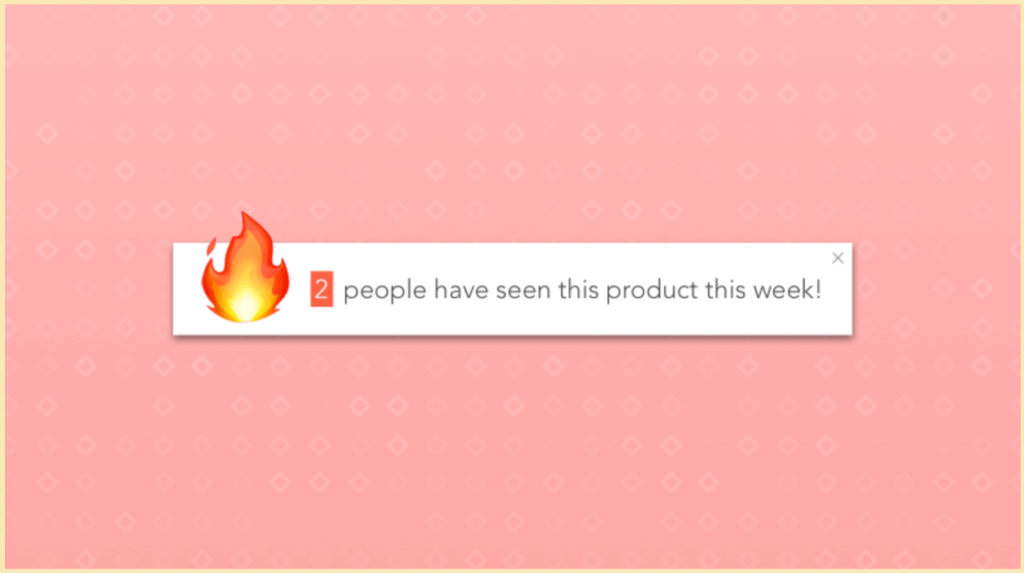
Source: Crobox
Imagine a flier pinned down at the front door of your apartment building that reads the following: “Less than 70% of people living in this apartment building took part in this year’s census”, followed by the CTA: “Don’t forget to do it online by March 31st” and “Thank you for your participation.”
At first glance it seems quite logical – You want to make your message seem urgent, so you tell people that there’s still a lot of people who haven’t done something yet. This will make them more likely to do it, right?
Negative Social Proof
Be careful about negative social proof. If you want people to do something, don’t tell them that the majority isn’t doing it.
Errr, except…when was the last time you ordered something a waiter told you very few people ordered? Instead you probably inquired about the most popular dish.
It’s ironic that the city council has the numbers to use a social proof, they just chose the wrong kind of framing. And yet this mistake would be very hard to foresee! Because what they did seems so logical.
So a different message might work better:
“7 out of 10 people living in this building already took part in this year’s census.”
They could make an even stronger push with: “Join the majority of your neighbors who want to see their taxpayer money put to good use for improving community projects,” which shows people the “why” behind the “how”.
Summary
What is social proof?
Social proof is our tendency to be influenced by what others do and how they think and behave. Social proof works particularly well in situations where there’s a great deal of uncertainty.
How to avoid social proof?
Overall, ask yourself why you would feel inclined to take someone’s word for it? Are they really relatable? Do they have similar needs?
Question the authority source: is the wisdom of the crown really the best source of expertise on what new gadget or gizmo to buy? Perhaps they have different needs from yours.
You can reinforce your persuasion armor if you do your own research first and stop relying on knee-jerk, gut feeling decisions of what the herd wants.
How to use social proof in your business?
- If you want social proof to be persuasive, you shouldn’t just say what many people end up doing. Say what the majority does. Make sure to adjust the reference group (those you want your customer to identify with to make it seem like they have something in common and/or are on the same boat).
- Use it in an innovative way. Most customers are used to coming across some form of social proof and it’s starting to suffer from “banner blindness syndrome.” This means you’ll need more than just general praise for your product or service to persuade visitors to take on your offer. Use social proof to counter hesitations and erase uncertainties. Ask what are the reasons customers might not want to convert? Adjust your testimonials to counter actual objections.
- Be careful about negative social proof. If you want people to do something, don’t tell them that the majority of people aren’t doing it. This will only make them not do it as well.
Additional resources:
- Top 16 Ways to use the Social Proof in Marketing in 2022
- Social proof: How to use psychology in digital marketing
- The Power of Social Proof for Brands
- Social Proof: What Is It and How To Use It in Marketing
- Social Proof: What Is It And How To Use It In Your Marketing Strategy
- Social Proof and Sales: How They Work Together
- 5 Social Proof Tips to Boost Email Marketing Results
- The Complete Guide to Social Proof in eCommerce
- 4 Important Types Of Social Proof
- The Psychology of Marketing: 18 Ways to Use Social Proof to Boost Your Results
- The Psychology of Social Proof Marketing
- Use Social Proof Examples in Your Marketing Strategy To Build Brand Trust
- What Is Social Proof and How Can Your School Use It?
- 3 Best Practices of Using Social Proof Marketing for your Company
- 9 Eye-Opening Examples of Behavioural Economics in Marketing

